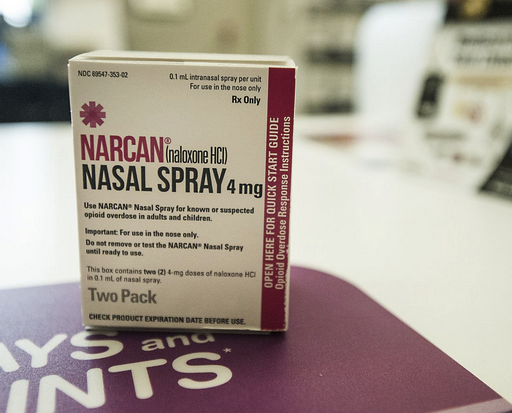The dose belonged to the suspect who also allegedly owned the illicit drug the trooper had been exposed to.
June 24, 2021
KAWKAWLIN, MI — When a Michigan State Police trooper began feeling the effects of a narcotics overdose during a traffic stop, a quick dose of Narcan kept the worst at bay. The dose belonged to the suspect who also allegedly owned the illicit drug the trooper had been exposed to.
These details were contained in a police report obtained by MLive-The Bay City Times via a Freedom of Information Act request.
The reports, portions of which are redacted, state that the afternoon of May 19, police were advised by Bay County Central Dispatch to be on the lookout for “a vehicle that was all over the road” in northern Bay County. Two MSP troopers spotted the vehicle in question, a gray 2011 Chevrolet Impala, on southbound M-13/Huron Road near Linwood Road in Kawkawlin Township.
Troopers saw the Impala twice cross the center line divider, their reports state. They pulled over the car and began speaking with the driver, a 32-year-old man, who said he was on his way to pick up his girlfriend from work.
The driver “was acting nervous” and was “involuntarily shaking while attempting to handle documents for the vehicle,” the report states. On the driver’s lap was a towel with apparent dried blood drops on it, the report states.
The driver stepped out of the vehicle and told troopers he had recently been arrested on breaking-and-entering and drugs charges, saying he had stolen pills to sell them for profit. He gave troopers permission to search his vehicle upon their request, the report states.
On searching the car, troopers found used syringes, a measuring scale, Ziplock bags, a bag of unused syringes, a bag of spoons bearing burn marks, and a bag of marijuana, the reports state. Questioned about the car’s contents, the driver told police he had bought heroin in Saginaw and used it four or five hours earlier.
As one trooper spoke with the driver, the other trooper searcher the driver’s wallet. He found inside it two plastic baggies containing a grayish powdery substance.
The driver “hung his head and shook from side to side in disappointment,” troopers wrote. “(He) advised the substance found was heroin. (He) advised, ‘There goes my job’ (and that) he was scared.”
About that time, one of the troopers began feeling the effects of an opiate overdose from his exposure to the driver’s alleged drugs.
“I recovered a dose of Narcan that was found in the suspect’s vehicle,” the other trooper wrote. “I gave one dose of Narcan to (the other trooper).”
The affected trooper never lost full consciousness, the reports state. He was taken to St. Mary’s Hospital in Saginaw for a medical evaluation.
The civilian driver was taken to McLaren Bay Region hospital in Bay City for a sample of his blood to be taken. After that, he was evaluated by an MSP drug recognition expert. The driver told the expert he uses about a ½ gram of heroin a day, just to keep withdrawal at bay.
The driver was then lodged in the Bay County Jail. His name is being withheld as he has not been charged with a crime related to the May 19 incident.
Narcan, also known by its generic name naloxone, is an opiate-antagonist used to bring users out of an overdose.
While all MSP troopers have been equipped with Narcan, the dose used on the affected trooper belonged to the driver, confirmed Lt. Kimberly Vetter.
Police previously said it is believed the trooper was actually exposed to fentanyl, a synthetic opioid that is 100 times more powerful than heroin and can be lethal to humans at the 2-milligram range. It has been linked to contributing to higher overdose rates across the nation in recent years.
The trooper returned to active duty after being cleared to so by medical professionals, Vetter said. She could not say when he returned to work, citing the Health Insurance Portability and Accountability Act (or HIPAA), but said he has fully recovered.
The troopers’ report does not state the results of the driver’s blood analysis.
Accidental drug overdose is considered the leading cause of death for those under 50 in the U.S., according to drugpolicy.org.
Michigan experienced a 19.6% increase in the number of opiate-related fatal overdoses from 2015 to 2016 and a 13.9% increase from 2016 to 2017, according to the U.S. Centers for Disease Control and Prevention. The CDC reports that Michigan’s rate of drug overdose deaths in 2018 was “statistically similar” to its 2017 rate.
The rate of overdose deaths involving synthetic opioids increased more than 16% from 2018 to 2019, with such deaths in the latter year being nearly 12 times higher than they were in 2013, the CDC reports.
Between May 2019 and May 2020, more than 81,000 people died of drug overdoses in the United States, “the highest number of overdose deaths ever recorded in a 12-month period,” the CDC reports. The ongoing COVID-19 pandemic is believed to be a factor contributing to the rising number of fatal overdoses.
The Michigan Department of Health and Human Services reported on April 15 that Michigan experienced 2,354 overdose deaths in 2019, 1,768 of which — 75.1% —involved opiates.
Overall overdose deaths declined by 9.4% from the 2,599 in 2018. Opiate-related overdoses decreased by 13.2% from the 2018 total of 2,036, the MDHHS reports.
However, preliminary data for January through June 2020 show 1,340 overdose deaths, an increase from 1,155 in those same months of the previous year. That’s an increase of 16%.
Opiate-related overdose deaths have also increased from 874 in the first half of 2019 to 1,045 in the same period in 2020, an uptick of 20%.
“Our efforts to prevent opioid misuse, provide high-quality recovery treatment and reduce the harm caused by opioids to individuals and their communities are paying off,” said Dr. Joneigh Khaldun, chief medical executive and chief deputy for health for MDHHS. “We have made significant progress, however, our preliminary 2020 data is showing there may have been an uptick in deaths last year. This illustrates that there is much more work to do and we will not rest until we have made further progress in addressing an issue that has devastated far too many families.”



